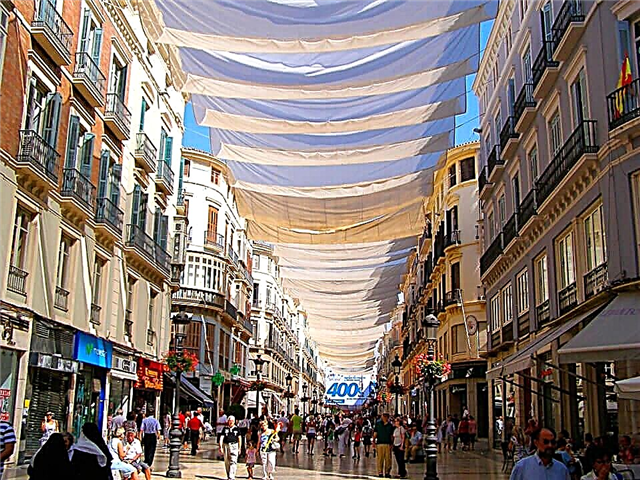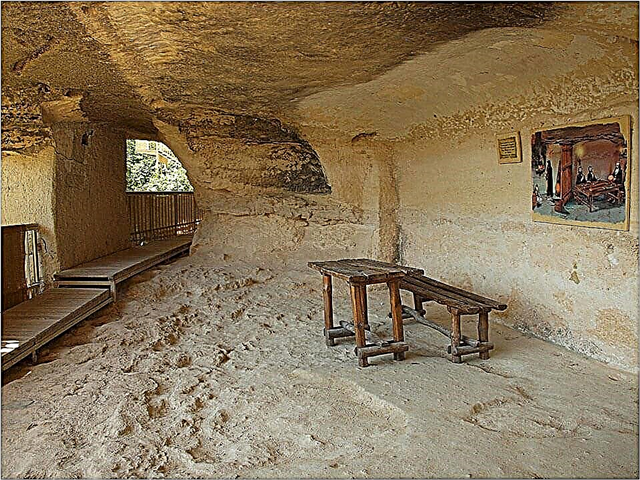The first Globe Theater was built in 1599. It was a round, roofless building intended for summer performances. It owes its original name to the sculpture of Atlanta standing at the entrance, holding a ball (Latin globus, "ball") on his shoulders. On the ribbon wrapped around it, the words: "The whole world is a theater" were read.
The first "Globe" from the time of Shakespeare

During the construction of the First Globe, the wooden structures of an old theater belonging to the Burbage dynasty of actors since 1576 were used. It was located in the city limits of London in the Shoreditch area and ceased to exist in 1597 due to the prohibitive rent for the land on which it stood. Then he was dismantled by logs and transferred to the south bank of the Thames. This place was in the suburbs and the rent was much lower here. In 1599, the theater was assembled and began its work.
The first "Globe" belonged to six owners who formed the backbone of the troupe. Their shares were different, the main funds were invested by two actors - the Burbidzhi brothers. William Shakespeare, the author of the plays, had at first 12.5%, and then his share decreased to 8%. The profit from the performances was distributed in proportion to the invested funds. The troupe also included hired actors who worked only for a salary.
The theater did not last long: only 14 years. In June 1613, during the premiere of the play based on Shakespeare's play "Henry VIII", there was a fire. Due to an unsuccessful stage shot, as a result of which a spark hit the thatched roof, the building caught fire and burned down in two hours. Fortunately, no one was hurt.
Second "Globe". Excavations

The following year, the burnt building was rebuilt, but as a precaution, it was built of stone, and the roof was covered with tiles. By this time, Shakespeare had already left the troupe, but the theater was inextricably linked with his name, the plays of the great playwright were still successfully staged on stage. The second "Globe" lasted until 1642 and was closed by the Cromwell government, which encouraged aggressive Puritans who rejected any kind of entertainment. They did not recognize the cultural and educational role of art, but perceived it as a hotbed of immorality and debauchery. In a short time, all theaters in England were closed, including the Globe.
After 2 years, the building was razed to the ground, and cheap accommodation houses were built in its place. Over time, they also disappeared, and the place where the temple of Melpomene, beloved by the audience, once stood, seemed to be lost forever. However, in 1989, the remains of the foundation of an old building were discovered. Comparing its configuration with the descriptions preserved in the archives, we came to the conclusion that this is the glorious Globus Theater. It turned out that the building, which was considered to be round, is in fact a polygon with 20 faces. A more detailed study was not carried out, since the foundation is located on the territory of the historical monument Anchor Terrace and excavations are prohibited. We limited ourselves to marking the contours of the foundation.
Central Park Hotel
London
Located less than 100 meters from Hyde Park

Hotel Edward Paddington
London
Minutes from Paddington Station and Hyde Park

DoubleTree by Hilton London - Docklands Riverside
London
Located on the embankment of the Thames

Park Plaza County Hall London
London
Just minutes from the banks of the Thames and the London Eye

What was the theater building under Shakespeare

There is no reliable information about the appearance and interior of the "Globus". According to the available documents, descriptions, fragments of drawings of a similar theater "Swan", the remains of the foundation, paintings of the city landscapes of London at that time, it was possible to restore only an approximate appearance. Externally, the building looked like a twenty-sided one. The auditorium had the shape of an oval platform measuring 29.6 * 31.1 m, surrounded by wooden walls. A thatched roof covered the upper seating areas and stage.
The central part of the building was in the open air, so the performances were held only in the warm season - from May to September in the daytime. There were no intermissions, the scenery was almost not used, they were replaced by signs with the inscriptions: "Forest", "Garden", etc. After the loud signal of the trumpet, the audience took their places, they collected a fee and the performance began. The actors were exclusively men, who also performed female roles.
Coca-Cola London Eye Ticket - £ 24.30
Tower of London and Royal Treasure Exhibition Ticket - £ 26.80
Tower Bridge Ticket - £ 9.80
Westminster Abbey entrance ticket and audio guide - £ 20
Madame Tussauds ticket - £ 29
St Paul's Cathedral Fast Track Ticket - £ 16
Skyscraper "Shard" - entrance ticket and champagne - £ 24.95
Spectator seats

The theater accommodated, according to various sources, from 1200 to 3000 spectators, was available to all classes. Seating seats - wooden benches were located along the perimeter of the wall in three tiers and surrounded the stage on three sides. The lower tier was at the level of the stage, the aristocracy sat there, the second and third were intended for wealthy citizens. For especially honorable spectators, there were several seats on the side of the stage.
The prices for the seats varied depending on the prestige, the most expensive were on the stage. The poor, who bought cheap tickets at one penalty, watched the performances, standing around the stage, from the so-called "pit". There were about 700 such places. The atmosphere in the auditorium was relaxed. During the performances, the audience actively participated in the action, loudly approving or condemning the actors' play, exchanged remarks, ate nuts and oranges, throwing waste at their feet. It was not forbidden to relieve natural needs on the spot.
Backstage and seats for musicians

The stage, 13 m wide and 8 m deep, protruded into the auditorium as a rectangle and did not have a curtain. It was raised above the floor by about 1.2 - 1.5 m. The place around the stage was called a "pit". There was a free space between the stage and the floor, covered with curtains. The inventory was kept there, which was served through the hatch on the stage. Through the hatch in the course of the action, sinners fell into the "underworld", from it came the inhabitants of the underworld, ghosts, devils, witches.
At the back of the stage there were three doors, behind which the actors changed their clothes and went out to the audience. Above the stage, in the back, there was a platform used in performances as a castle wall or a balcony. Characters appeared on it: Juliet, the shadow of Hamlet's father, heralds, and so on. In addition, the upper platform sometimes housed live musicians. There was no definite place for the musicians, so they appeared on the stage, creating a unique mood by playing simple musical instruments: lute, drum, flute.
There was a small room above the balcony. It resembled a hut with two windows, from which the artists appeared during the enacted scenes and delivered monologues. On the roof of the hut, a flag was fixed, by the color of which the inhabitants of the neighborhood determined which performance was going on: black color corresponded to tragedy, white color to comedy, red to historical drama. The stage was covered with a thatched roof - "heaven", which was supported by two powerful columns, was painted on the inside with the signs of the zodiac. There was a hatch in it, from which representatives of the other world descended on ropes: angels, gods, spirits.
Theater today

The Globe was forgotten for more than 300 years. Its restoration began with an idea belonging to American Sam Wanamaker, a famous actor and director. The British were skeptical about his proposal, and refused to finance the project. In 1970, Wanamaker creates a fund to finance the construction, bit by bit collects materials about the structure of the building, attracts architects and builders. The construction of the building began at a distance of 200 m from the historical site of the first theater. In 1993, when the frame was built, Wanamaker died.His followers completed the project in 1997. Queen Elizabeth II herself opened the new "Globe".
Its appearance is as close as possible to the original sample. It is a roofless summer theater, built of massive oak logs, the covering above the stage and the upper tier is made of straw, which is the first time in London in 300 years. For safety reasons, all building materials are impregnated with fire-fighting compounds. As in the days of Shakespeare, in the theater, a stage protruding into the auditorium, the seating places are located on three tiers, and the standing (500 places) around the stage.
The modern "Globe" is designed for 1600 people and is one of the most visited places in London. Standing places are the cheapest, popular with students and young people. In total, more than 250 thousand people attend performances per season. The season runs from late April to mid September. Out of season, visitors are attracted by the museum at the theater, which contains costumes and utensils from the time of Shakespeare, sketches, models, and decorations. The museum contains interesting facts about the life and work of the playwright, his works and personal belongings.
Performances

There is no permanent troupe in the theater; a new cast is formed every year. The Globe's repertoire consists mainly of Shakespearean plays: The Taming of the Shrew, As You Like It, The Merchant of Venice, Henry IV, Othello, Hamlet, King Lear, Macbeth. Plays by other well-known authors and young English playwrights are staged, and drama groups from different countries are on tour. The performances take place during the day, as artificial lighting is not used, as well as any voice amplifiers. The performances differ from the medieval ones in that the roles are played not only by men, but also by women.
Copies of the theater in other countries
"Globus" won love all over the world. Its great popularity among fans of the performing arts is due to the fact that it conveys the atmosphere of theatrical performances of the Shakespearean era and allows the audience to travel back to that ancient time. Copies of the London Globe Theater have been created in many cities around the world. They cannot be called accurate, they are rather interpretations of the London theater, each of which has its own characteristics. A total of 12 of them were built: 6 - in US cities, 3 - in Germany, 1 - in Italy, 2 - in Russia. Russian theaters in Moscow and Novosibirsk, due to the peculiarities of the climate, have a roof and are not summer theaters.
Where is it and how to get there
The Globe Building is located in the heart of London's cultural Bankside, on the south side of the river across from the City of London. Its address: SE1 9DT, London, Bankside New Globe Walk, 21. The landmark is the Millennium Bridge, which is 50 meters away. In 10-15 minutes walk - underground stations: Blackfriars, London Bridge, Southwark and St. Paul.
You can also get there by buses:
- 45, 63, 100 to Blackfriars
- 15, 17 to Cannon Street
- 381, PB1 to Southwark Street
Open daily from 9:00 to 17:00.











